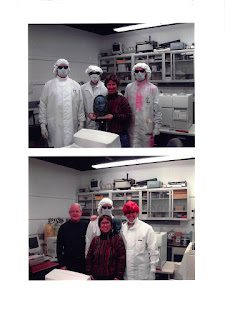 |
| Zero Gravity Space Team |
We’ve all watched those
space movies—Sandra Bullock floating around trying to repair a space ship, her
hair twirling around her head, waving herself around the universe. It’s as fun
as it looks, which I found out in 2004 on a trip on NASA’s Vomit Comet. In
order to train astronauts for the feeling of zero gravity, NASA has a special
plane taking off from Johnson Space Flight Center near Houston, Texas. In order
to achieve zero gravity, the aircraft, a large C-130 cargo jet aircraft,
follows a parabolic flight plan going up in an arc followed by descending in a
similar arc. During the upward climb, gravity is about double Earth’s gravity;
on the downward trajectory, gravity goes to zero.
My opportunity to fly on the Vomit Comet was made
possible by working with Jake Maule, a postdoc working with Andrew Steele.
Jake, now a physician at Duke University Hospital, is a trim, sharp-looking
Brit who had dreams of joining the astronaut core. His Ph.D. is in medicine, so
he was looking to use that training combined with an astrobiology theme to be
attractive to the very competitive NASA program for selecting astronauts. Jake
and I were both interested in immunology at that time. I had purchased an
instrument capable making the types of measurements that can detect complex
diseases like HIV-AIDS. The instrument, an ELISA reader (enzyme-linked immuno-sorbent
assay) measures the amount and strength that antibodies have in binding to the
molecules, antigens, they are trying to remove from harming our bodies. To
neutralize antigens, which are potentially harmful compounds, antibodies hook
up with antigens in complex physical structures.
Jake’s idea was to use the ELISA reader, to find out
whether and how antibodies and antigens hook up together without the benefit of
gravity. He asked to borrow my instrument. I told him, “OK, but you have to
take me with you!” He thought about it briefly, and agreed. We flew down to
Johnson Space Flight Center for 2 days of training. After a morning of
lectures, we went into a space simulation chamber that was evacuated leaving
almost no air, but all was fine because we were wearing oxygen masks. The
chamber was then filled with nitrogen gas—which does not support life—and we
were asked to remove our masks. It took me only 20 seconds to feel the
effects—I was unable to count to five! My mask went right back on.
Jake and I practiced our experiments in a lab on the
ground. We planned to fly 40 cycles alternating between zero gravity and
two-times gravity (2-G) during our 3 hour flight. Each cycle lasted 20
seconds—barely enough time to complete the manipulations needed. The morning of
our flight we were given two medications to help—Dexedrine and scopolamine-one
to keep you awake and the other to keep you from getting airsick. Donning NASA
flight suits, 15 scientists, a flight supervisor, and the flight surgeon
entered the plane. Excitedly, we set up our experiments. Ours was inside of a
newborn baby’s Isolette, a plastic box with armholes for two people to attend
to a premature infant, which kept our supplies from floating around the
aircraft.
We were seated for takeoff, then at 10,000 feet we moved to
our workstations, where our feet were placed under straps so we wouldn’t float
away. When we were about to enter zero-G, special lights flashed on. Then, as
we switched to 2-G, the flight supervisor shouted, “Feet down! Comin’ up!” We
heard that phrase more than 40 times.
The first zero-G experience made your stomach do a
flip-flop. Your hair raises up, your equipment floats around. Wow! Then, all too
soon, you feel 2-G making you twice your body weight. A slight movement of your
head and you felt nauseous, even going so far as to cause vomiting. On the
second cycle, we began the manipulations. My skills on working at sea on ships
tossed around by big waves trained me for this work. Opposite to me, Jake was
turning a bit green. The flight surgeon floated by, offered him a barf bag,
wrapped it up, and then went on to the next scientist who needed some help. I’m
proud to say my stomach remained in check.
After 40 cycles of zero G, Jake and I unplugged and
floated for the next couple of parabolas. The feeling of weightlessness, even
for 20 seconds, is something my body has never forgotten. The ability to float
in air, even fly, is something we only dream about but never experience. The
trip on the Vomit Comet let my soul soar!
Because I was a trooper on the flight, the pilots invited
me to sit in the jump seat just behind them when we were returning to Johnson.
What an eye opener! First, I saw how
close we were to another airplane and how the pilots handled that. Then, a
warning light came on in the panel of instruments on the plane’s dashboard. We
were all connected via headsets, so I could hear them discussing the meaning of
the orange light. Apparently, it had to do with the functioning of one of the
two jet engines. After we safely landed, the plane was taken into a hanger for
maintenance to figure out what was happening with that engine. Turns out that
it needed to be completely overhauled. Our 2nd flight was cancelled
and the Vomit Comet was out of commission for months.
Our experiments were successful. We determined that
antibodies and antigens had no problems working in the absence of gravity.
Although humans evolved with the benefits of a gravitational field, our
biochemical systems could adapt to spaceflight.




No comments:
Post a Comment